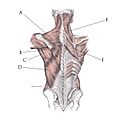Human back facts for kids
The human back is the large area at the back of your body. It goes from your bottom up to your neck and shoulders. Think of it as the opposite side of your chest. Inside your back is the spinal column, which is like a strong stack of bones. This column runs down the middle of your back. Your shoulders at the top and your pelvis (hip bones) at the bottom make your back wide.
Sometimes, people get back pain. It's a very common problem, but usually it's not serious.
Contents
What Makes Up Your Back?
The most important part of your back is your spinal column. This column of bones, called vertebrae, goes from the top of your chest area down to your lower back. It protects your spinal cord, which is like a superhighway for messages between your brain and body. Your spine also has natural curves that give your back its shape.
Your ribcage starts at the top of your back and goes more than halfway down. This protects your lungs and other organs. Below the ribcage, there's less protection until you reach your hips. The wide bones of your shoulders, called scapula, define how wide your upper back is.
Back Muscles
Many muscles are found along your spine. Some tiny muscles help each vertebra move. Other muscles help your whole spine move.
Other muscles in your back help you move your neck and shoulders. The trapezius muscle is shaped like a diamond. It connects your neck, shoulders, and upper back. The large latissimus dorsi muscles form a triangle shape from your shoulder down to your hip.
Organs in Your Back
Your lungs are inside your ribcage. They reach around to the back of your ribcage. This is why doctors can listen to your lungs from your back. Your kidneys are located lower down, below your ribcage muscles. They are loosely connected to your belly area. A hard hit to your lower back can hurt your kidneys.
The Skin on Your Back
The skin on your back is thicker than on most other parts of your body. It also has fewer nerve endings. This means it's not as sensitive to touch as other areas. For most people, it's also the one part of their body they can't easily reach to scratch!
How Your Back Moves
Your back is amazing! It supports your head and body. It also gives you strength and allows for a lot of movement. Your upper back, where your ribs are attached, is very strong and doesn't move much. But your lower back (the lumbar area) is very flexible. It lets you bend forward and backward. However, it's not designed for twisting motions.
Back Pain: What to Know
Back pain is very common. Your back has many parts that can cause pain, like nerves, bones, muscles, and ligaments (which connect bones). The most common reason for back pain is a muscle strain. This means you've pulled or stretched a muscle too much.
Even though muscle strains can hurt a lot, they usually heal on their own in a few weeks. Other causes of back pain can include problems with the soft cushions between your vertebrae, called discs. Sometimes, small cracks in the bones can also cause pain.
Images for kids
See also
 In Spanish: Espalda para niños
In Spanish: Espalda para niños




